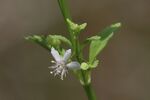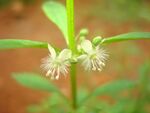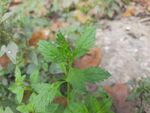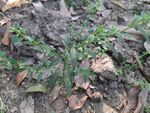Biology:Scoparia dulcis
| Scoparia dulcis | |
|---|---|
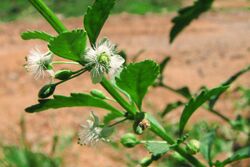
| |
| Scientific classification | |
| Kingdom: | Plantae |
| Clade: | Tracheophytes |
| Clade: | Angiosperms |
| Clade: | Eudicots |
| Clade: | Asterids |
| Order: | Lamiales |
| Family: | Plantaginaceae |
| Genus: | Scoparia |
| Species: | S. dulcis
|
| Binomial name | |
| Scoparia dulcis | |
| Synonyms[1] | |
| |
Scoparia dulcis is a species of flowering plant in the plantain family. Common names include licorice weed,[2] goatweed,[3] scoparia-weed and sweet-broom in English, tapeiçava, tapixaba, and vassourinha in Portuguese, escobillo in Spanish, and tipychä kuratu in Guarani.[4] It is native to the Neotropics but it can be found throughout the tropical and subtropical world.[4]
Although S. dulcis is considered a weed in many parts of India and Bangladesh, its use in traditional medicine has led to overexploitation.[5] The plant is also found as a weed in American citrus groves.[3]
Traditional medicine
As a traditional medicine, S. dulcis has been used for diabetes in India and hypertension in Taiwan.[6] In Siddha medicine it is used for treatment of kidney stones, but it needs rigorous diet method. It is called kallurukki (stone melter) in Malayalam and Tamil. In Brazil , it has been used for various problems such as hemorrhoids and wounds.[7]
Chemical constituents
Chemicals that have been isolated from S. dulcis include scoparinol[8] and epinephrine.[9] 10. Chiu-Ming Chen; Ming-Tyan Chen (1976). “6-Methoxybenzoxazolinone and Triterpenoids from Roots of Scoparia dulcis” Phytochemistry, 15:1997-1999.
Gallery
References
- ↑ The Plant List: A Working List of All Plant Species, http://www.theplantlist.org/tpl1.1/record/kew-2585469, retrieved 22 May 2016
- ↑ "Scoparia dulcis". Natural Resources Conservation Service PLANTS Database. USDA. https://plants.usda.gov/core/profile?symbol=SCDU3. Retrieved 8 November 2015.
- ↑ 3.0 3.1 Jain, Rakesh; Singh, Megh (1989). "Factors Affecting Goatweed (Scoparia dulcis) Seed Germination". Weed Science 37 (6): 766–70. doi:10.1017/S0043174500072817.
- ↑ 4.0 4.1 {{citation | mode = cs1 | title = Scoparia dulcis | work = Germplasm Resources Information Network (GRIN) | url = | publisher = [[Organization:Agricultural Research ServAgricultural Research Service (ARS), United States Department of Agriculture (USDA) | access-date = 19 January 2018 }}
- ↑ Majumder, S; Rahman, MM; Bhadra, SK (2011). "Micropropagation of Scoparia dulcis Linn. through induction of indirect organogenesis". Asia-Pacific Journal of Molecular Biology and Biotechnology 19 (1): 11–7. http://www.msmbb.org.my/apjmbb/html191/191b.pdf.
- ↑ Pari, Leelavinothan; Latha, Muniappan (2004). "Protective role of Scoparia dulcis plant extract on brain antioxidant status and lipidperoxidation in STZ diabetic male Wistar rats". BMC Complementary and Alternative Medicine 4: 16. doi:10.1186/1472-6882-4-16. PMID 15522116.
- ↑ Freire, SM; Torres, LM; Souccar, C; Lapa, AJ (1996). "Sympathomimetic effects of Scoparia dulcis L. And catecholamines isolated from plant extracts". The Journal of Pharmacy and Pharmacology 48 (6): 624–8. doi:10.1111/j.2042-7158.1996.tb05985.x. PMID 8832498.
- ↑ Ahmed, M; Shikha, HA; Sadhu, SK; Rahman, MT; Datta, BK (2001). "Analgesic, diuretic, and anti-inflammatory principle from Scoparia dulcis". Die Pharmazie 56 (8): 657–60. PMID 11534346.
- ↑ Phan, Minh Giang (2006). "Chemical and Biological Evaluation on Scopadulane-Type Diterpenoids from Scoparia dulcis of Vietnamese Origin". Chemical and Pharmaceutical Bulletin 54 (4): 546–549.
External links
Wikidata ☰ Q7787299 entry
 |

